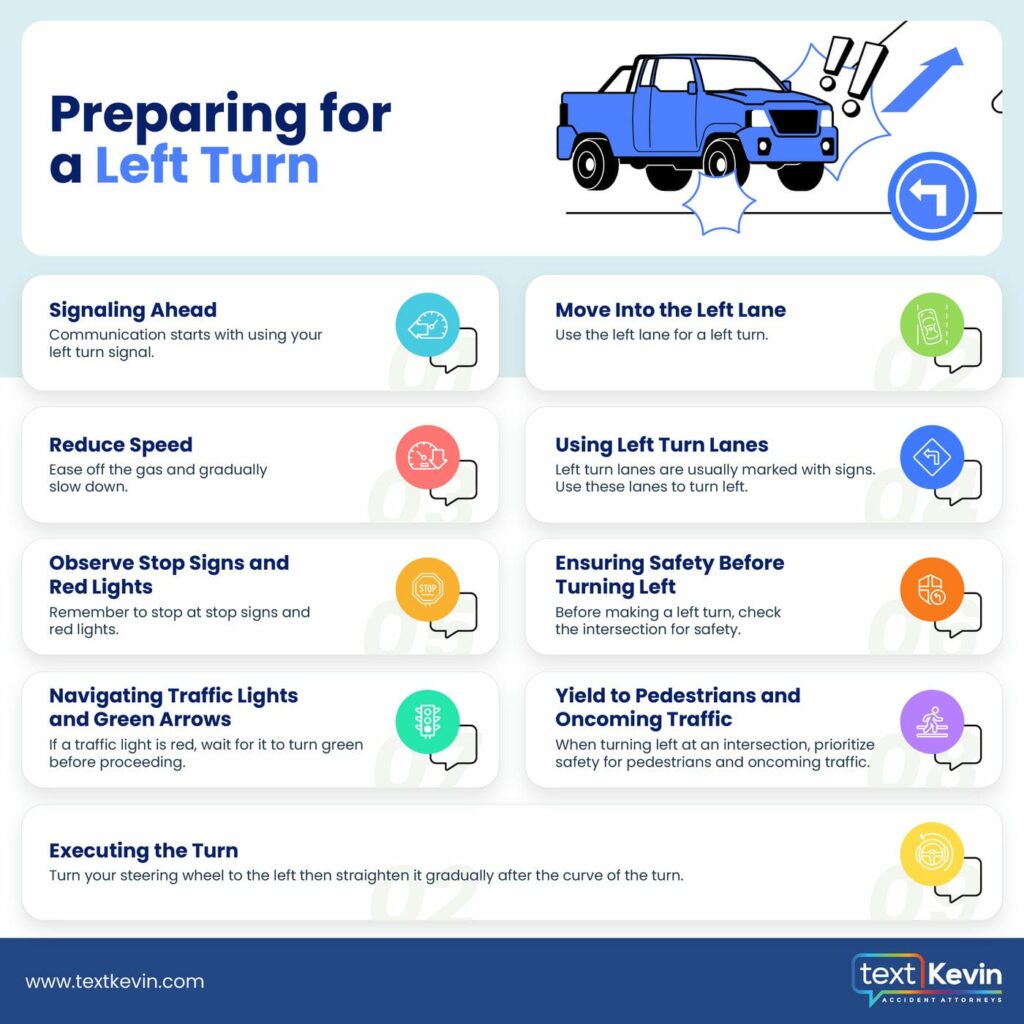Making a left turn at an intersection might look a bit challenging at first, especially since it involves moving across lanes where other cars are coming towards you. However, with the right approach, it can be pretty easy and safe. The key is to always signal your intentions to others by using your turn signal well in advance. It’s also important to follow all traffic lights and signs to know when it’s your turn to go.
Before you make that turn, take a good look at any cars coming your way or people walking across the street. It’s important to wait and let them pass by safely before you proceed. This careful approach helps prevent accidents and keeps everyone on the road safe.
Remember, making a left turn isn’t just about finding the right moment to go; it’s also about ensuring that the way is clear and that you’re not putting yourself or others in danger.
Preparing for a Left Turn: Signaling Ahead
When you’re getting ready to make a left turn at an intersection, communicate your intention to everyone on the road. This communication starts with using your left turn signal. You should activate your turn signal at least 100 feet (30 meters) before you reach the turn. There’s a simple lever on the left side of your steering wheel designed for this purpose. Pushing it down will turn on your left signal light.
This action does more than just light up a part of your car. It sends a clear message to other drivers, pedestrians, and cyclists that you’re planning to move left. By signaling early, you give others enough time to adjust their speed, prepare to stop, or make room for your turn. This is not just a courteous thing to do; it’s a safety measure that can significantly reduce the risk of accidents.
Note
Always remember, turning on your signal is a fundamental part of safe driving. It’s a habit that helps ensure not just your safety, but also that of everyone sharing the road with you. Whether you’re turning, changing lanes, or merging into traffic, the turn signal is your best tool for clear communication. Making it a consistent part of your driving routine is essential for preventing misunderstandings and collisions.
Positioning Yourself Correctly: Moving into the Left Lane
When driving on a two-lane road, use the left lane for a left turn. Signal left, check mirrors, then shift lanes safely. If a car is in the left lane, slow down to merge. Avoid cutting them off for a smooth transition.
Turning left from the right lane is dangerous and wrong. The left lane signals your intentions clearly to others. It offers the best angle for a safe turn. It follows traffic rules, ensuring order on roads.
Tip
Positioning early for a left turn is crucial for safety. It shows respect for rules and others on the road. By being proactive, you make driving safer for all.
Reduce Speed
When making a left turn, here’s what you do:
Ease off the gas and slow down gradually. Let your car naturally slow down.
Apply the brake gently but firmly before the turn. This helps you navigate safely.
Pro Tip
For manual transmission drivers, here’s an extra step: Shift to neutral as you slow down. This helps manage your speed better. It disengages the engine from the wheels.
Utilizing the Designated Left Turn Lane
At many intersections, you’ll find a lane specifically designated for making left turns. This lane is usually marked with signs or road markings. If you’re approaching an intersection with such a lane, make sure to signal your intention to turn left and then move into the designated lane as soon as it’s safe to do so. Once you’re in the left turn lane, keep your turn signal on to remind others of your intention to turn.
While you’re waiting in the left turn lane, either at a stop sign or a red light, maintaining your turn signal helps communicate your plans to other drivers and pedestrians. This continued communication is vital for preventing accidents and ensuring the flow of traffic is uninterrupted.
Being in the correct lane and using your turn signal consistently are simple yet effective ways to enhance safety on the road.
Observing Stop Signs and Red Lights
When you approach intersections, remember to stop at stop signs and red lights. Whether you see a stop sign or a red light, the rule is simple: stop completely. At stop signs, halt at the white line or before the crosswalk. At red lights, stop before the crosswalk to let pedestrians cross.
Take a moment to check for other vehicles, cyclists, and pedestrians. It shows respect for traffic rules and promotes mutual respect.
Stopping at stop signs and red lights prevents accidents. Intersections are common collision spots due to signal misunderstandings. Stopping lowers the risk and creates a safer road. It shows your commitment to safety and sets a good example.
Ensuring Safety Before Turning Left
Before making a left turn, check the intersection for safety. Look around for oncoming traffic and pedestrians crossing. Wait for oncoming vehicles to pass before turning left. Rushing can lead to accidents.
Some intersections restrict left turns with specific signs. Follow these signs to avoid violations and accidents.
Following these rules makes driving safer for everyone. Responsible driving includes cautious decisions at intersections, especially for left turns.
Navigating Traffic Lights and Green Arrows
When you’re at an intersection waiting to make a left turn, watch the traffic light. If it’s controlled by a traffic light, wait for the green light. Make sure it’s fully green before moving forward. This prevents accidents and keeps traffic orderly.
At some intersections, you’ll see a green arrow. This arrow gives you the right of way to turn left. It’s safe to enter the intersection. A solid green light means you can go but yield first. The green arrow adds clarity and safety.
Knowing these signals is important for intersection safety. A green arrow allows a smooth left turn. A solid green light needs caution and yielding. Following these rules makes intersections safer for everyone.
Yielding to Pedestrians and Oncoming Traffic
When turning left at an intersection, especially without a green arrow, prioritize safety for pedestrians and oncoming vehicles.
Pedestrians and oncoming vehicles have the right of way over your turn. Remember to wait and let them go first.
Yielding is important for safety, not just politeness. Pedestrians need extra care as they are more vulnerable.
Oncoming vehicles might not anticipate your turn. Neglecting to yield can cause accidents in such cases. It endangers others and yourself.
Breaking road rules can also lead to fines and penalties. Non-compliance affects your driving record and insurance rates.
Executing the Turn
With your vehicle correctly positioned, begin the actual turning process by gradually turning the steering wheel to the left.
It’s important to maintain a gentle touch on the gas pedal to ensure a smooth entry into the turn.
If you’re turning onto a road with two lanes going in one direction, aim to enter the leftmost lane. Entering directly into the right lane from a left turn is not only unsafe but also against traffic rules in many places.
Maintaining a Smooth Turn
As you navigate the turn, keep the movement of the steering wheel steady and consistent. Sudden or jerky movements can disrupt the flow of the turn, potentially causing you to stray into an incorrect lane or lose control. Smooth, deliberate steering helps maintain your vehicle’s stability and ensures a safe turn.
Completing the Turn
After navigating the curve of the turn, begin to straighten your steering wheel gradually. This action will align your vehicle with the direction of the lane you’re entering.
Once the turn is complete, and your car is aligned straight on the road, you can gradually increase your speed to match the flow of traffic. To stay in control, make sure your steering wheel’s centered. It’s key for a safe and smooth ride ahead.
Each of these steps highlights the importance of careful preparation, awareness, and execution when making a left turn at an intersection. By following these guidelines, drivers can minimize risks and contribute to a safer driving environment for everyone on the road.

Contact Kevin Crockett for Legal Support
If you’ve been involved in a road accident and need legal guidance, Kevin Crockett and his dedicated team at Crockett Law Group are ready to assist you. Whether you prefer to call, text, chat, or email, we offer multiple ways to get in touch, ensuring you receive the support you need when you need it.
- Call: Reach out to us at [phone] for immediate assistance from our experienced team.
- Text Message: Send a quick text to (714) 492-1725 with your details, and we’ll guide you through your next steps.
- Chat: Access our live chat support any time for fast, reliable help by clicking “START CHAT.”
- Email: Email us your questions or concerns, and we’ll get back to you promptly to help you navigate your potential case.
Kevin Crockett, an award-winning personal injury lawyer, deeply understands the impact of accidents on individuals’ lives. With a strong background in personal injury law and a commitment to personal attention for each client, Kevin and his team are dedicated to fighting for your rights and ensuring you receive the justice and compensation you deserve. Trust in Kevin and his proven track record of success to help you through this challenging time.










